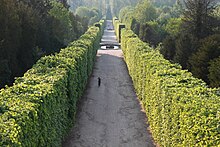Our website is made possible by displaying online advertisements to our visitors.
Please consider supporting us by disabling your ad blocker.
Bosquet

In the French formal garden, a bosquet (French, from Italian bosco, "grove, wood") is a formal plantation of trees in a wide variety of forms, some open at the bottom and others not. At a minimum a bosquet can be five trees of identical species planted as a quincunx (like a 5 dice), or set in strict regularity as to rank and file, so that the trunks line up as one passes along either face. In large gardens they were dense artificial woodland, often covering large areas, with tall hedges on the outside and other trees inside the hedges. Symbolic of order in a humanized and tamed gardens of the French Renaissance and Baroque French formal gardens, the bosquet is an analogue of the orderly orchard, an amenity that has been intimately associated with pleasure gardening from the earliest Persian gardens of the Achaemenid Empire.

Bosket is an English rendition of the word, now obselete; the usual English term for a large hedged bosquet was a "wilderness", while smaller unhedged ones were often called "groves".
Previous Page Next Page


